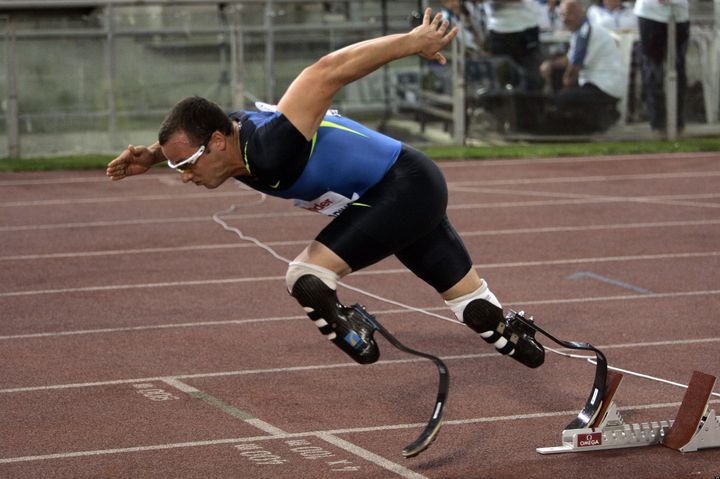
South African track runner Oscar Pistorius, though not a double amputee -- he was born without lower legs -- has enjoyed great success competing in that class wearing state-of-the-art carbon-fiber prosthetics. After setting world records in the 100, 200, and 400 meters, he sought to move up in weight class, if you will.
Initially, he was prohibited from competing against able-bodied runners on the grounds that, because they were a little too state-of-the-art, his prosthetics gave him an unfair advantage. (Of course, he was still allowed to crush other double-amputees.) Ultimately, though, he was cleared to compete against all runners. But the unfair-advantage issue is not a closed book.
At Sports Illustrated, David Epstein writes about a report in the Journal of Allied Physiology, in which two of the seven scientists belonging to the group that cleared Pistorius "now say that the so-called 'Cheetah' legs make Pistorius 10 seconds faster over 400 meters than he otherwise would be, a boost so significant as to make the difference between a mediocre high school runner and an Olympian."
One's first impulse is to think the advantage would be derived from his newfound ability to bound gazelle-like around the track. However, writes Epstein:
The researchers found that because the carbon fiber Cheetahs are about half the weigh. . . . of an able-bodied sprinter's lower leg, Pistorius can swing his lower leg through the air between strides 15.7 percent more quickly [than an] average of five former 100-meter world record holders. "Oscar is off the charts," said Peter Weyand, one of the researchers and an exercise physiologist at Southern Methodist University. "Clearly, with athletes with intact limbs, there's a lower limit to how fast they can reposition their limbs."
In fact, Weyand and the report's co-author Matthew Bundle (emphasis added) "concluded that Pistorius has the highest stride frequency ever recorded because of how quickly the lightweight Cheetahs allow him to whip his legs through the air." That also affords him, writes Epstein, "the liberty of spending more time with the foot of each Cheetah on the ground, generating force all the while." All told, said Weyand: "The muscular forces he has to generate are less than half of what an intact sprinter has to generate to go the same speed."
In fact, if you watch Pistorius run (this video is just 10 seconds long), you'll see that far from covering ground with great leaps and bounds while wearing the Cheetahs, his running style is earth-bound to the point of dead-legged. In other words, Pistorius's advantage is totally predicated on stride frequency, or what they refer to in track and field as "turnover." Stride length, Usain Bolt notwithstanding, is apparently of little significance. Think of the trundling style of the great Michael Johnson, for instance, who ran the same distances as Pistorius.
Running technique aside, his case shares some similarities with that of hermaphrodite 800-meter runner Caster Semenya, also from South Africa, who was recently allowed to keep her Olympic gold medal despite lingering questions about her sexual identity.
As Epstein wrote in an article on Ms. Semanya, a "professor of obstetrics, gynecology and molecular genetics, likened [her situation] to calling unfair a pituitary tumor that causes someone to grow to be 7-foot-5 and play in the NBA."
The case could be made that the efficiency of the prosthetics Pistorius is allowed to use should be governed. After all, the number of spikes allowed in a track shoe is limited. But, since we're dealing with the disabled, that would seem churlish.
In fact, is it too much to ask athletes poised to compete against Pistorius to act with maturity and learn to live with the situation? After all, like Ms. Semenya, Pistorius is an anomaly. Unless, of course, runners care to arrange an accident that results in the amputation of their lower legs. Then they, too, can obtain space-age prosthetics and become even more bionic than Pistorius.